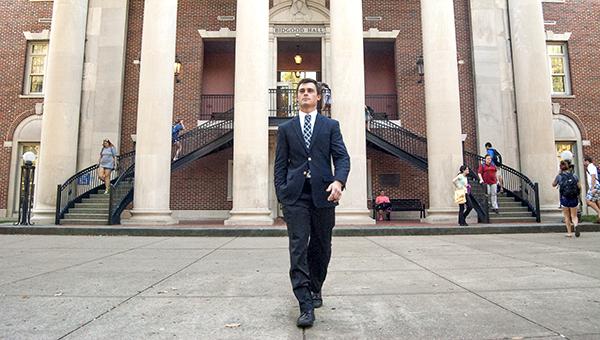Craig, a senior majoring in finance, has been dressing up for school for several years. He developed the habit during high school, and, with the exception of his freshman year at the University, has continued every year since.
“I found it a lot easier to focus in class when I was dressed well,” he said.
Craig’s typical wardrobe for class includes a button-down or a polo shirt paired with slacks or, on occasion, jeans, he said. Instead of a backpack, he carries a camel-colored briefcase.
“It’s kind of hard to take someone seriously if they’re wearing a suit and they have a nylon backpack on,” he said.
Gina Johnson, associate vice president of auxiliary services, teaches a noncredit seminar on dress etiquette for students in the business school. She became certified by Emily Post as a business etiquette trainer and conducts the seminars in hopes of improving the social polish of business students. Though it can be a difficult reality to face, appearances can have a large impact on how a person is perceived, she said.
“Fortunately or unfortunately, we make a judgment, some studies say within the first 20 seconds of meeting somebody,” she said. “And sometimes that judgment is made only on appearance.”
Johnson began the program in the early 1980s when she was the director of the business MBA program, and she continues to offer the seminars to students today. Instead of focusing completely on how students should dress for class, the seminars focus on building a wardrobe appropriate for the type of interviews and future career a student wishes to have. Attire changes with different careers, Johnson said, and Craig said he has realized that as well.
“I think that, especially going into a career where [professional attire] will be required every day, definitely makes me think it’s more important to do now and to learn how to be comfortable in professional clothes and be used to wearing them all day,” Craig said. “I think that it’s definitely more important than in other majors, where the dress codes in the career fields are more relaxed.”
In addition to the changes in dress code among different careers, Johnson said she has also noticed dress habits have changed in the student body over the years, due to multiple factors, such as weather conditions. “I think on this campus, casual dress for class is the norm,” She said. “But that’s not to say that some professors don’t set a standard to change the norm in their class or at particular times in their class.”
During her years as a professor in the business college, Johnson said she would require her students to dress up for presentations or for guest speakers, expectations are not much different from those of current professors. André L. Souza, assistant professor of psychology, has come across examples of appearances and their perceptions during his studies in cognitive psychology. Fashion psychology, a branch heavily researched by Karen Pine, delineates some of the ideas behind the implications that certain dress attire can have. Receiving trust and respect from others is one of the most basic ideas Pine’s research evaluates, he said.
“There are several things that will influence how you see other people, and dressing is just one of them,” Souza said. “The idea behind this is that we have a limited cognition. We need to use as few resources as we can and get as much information as we can.”
He said a few students dress up to his classes each day, and this may be done to boost self-esteem or to inspire different kinds of interactions with other students and professors. According to Pine’s research, clothing is related to self-esteem, and dressing differently can boost self-esteem. Dressing up can also be a way to establish one’s own identity.
Whether walking through campus or teaching a class, Souza said he can usually be found wearing a hat, which has led to some confusion, he said. Sometimes other faculty or his students confuse him for a student at the University.
“I think it’s part of my identity, wearing the hat,” he said. “But although it’s part of my identity, I am conscious about the implications of wearing it.” Society may also draw inferences from one’s clothing, Souza said. Pine’s research has shown attire can reflect the emotional state of a person. People who are less happy in the mornings may wear baggy clothing, but those who are happier may wear different colors or choose to wear a dress.
Despite the implications of attire, clothing isn’t the only part of one’s appearance that a professor may notice. Joseph Phelps, professor and chairman of the department of advertising and public relations, said he pays less attention to what students are wearing and more attention to how engaged they are in his lectures.
“I see faces and eyes and hopefully sometimes smiles,” he said. “I don’t really notice clothes as much.”
Phelps wears casual business attire to class each day but only puts great attention to his clothing on the first day of classes or when he has invited a guest to the class. As a college student, he dressed more for comfort and for the weather, wearing clothing he already had rather than spending more money on other clothes.
Katie Rose Carnes, a sophomore majoring in dance, said she chooses to wear more casual clothing to class. Her usual attire consists of a T-shirt or sweatshirt with shorts or leggings, depending on the weather, and she hasn’t ever received a comment on her clothing choice from a professor, she said.
“I prefer to dress more casually because I think it’s more comfortable,” Carnes said. “I would run out of dress clothes, and I feel like I apply myself better being comfortable versus being restricted in what I’m wearing.” Phelps said he understands the implications appearances carry, but ultimately, clothing choices are not going to determine whether or not students come to class to learn.









